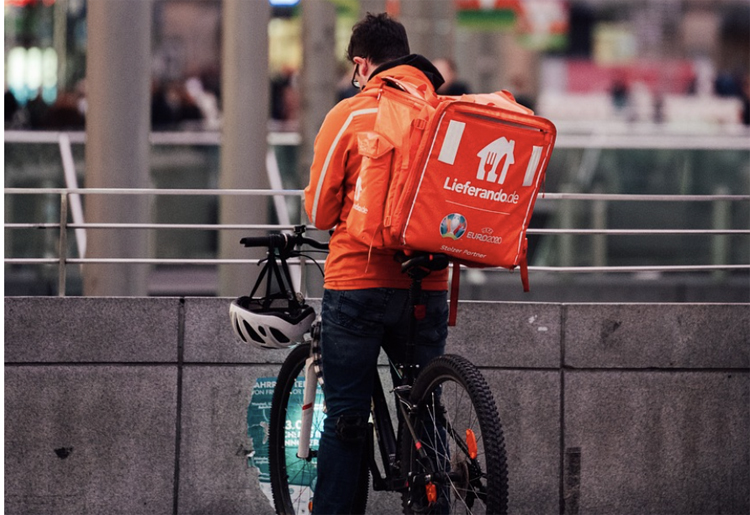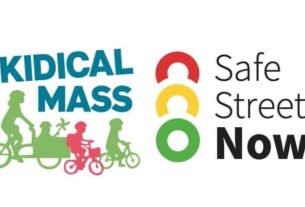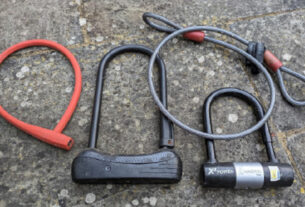While I was talking to Matt Touw, a man came in to have some work done on his bike. He was obviously well-known to Matt and although he declined to be photographed or even give me his name, on the strength of his continental accent I will call him Claud.
Claud told me that he worked as a delivery rider to supplement his income from his regular job and that he liked doing the work as he could fit in the hours to suit himself. Like most of the riders he was signed up to all the different apps, although he preferred Just Eat and an app called Stuart which he said paid best.
I asked him about his bike, which again he said he would prefer not to be photographed, and he told me that he was concerned to keep it in good condition and that he was one of Matt’s regular customers.
His bike was a fairly big name mountain bike which had been modified with a motor unit attached to the bottom bracket with sensors mounted on the rear forks and wheel. There was a very big battery pack housed in a triangular case mounted inside the frame and various displays and controllers fixed to the handlebars.
He was very concerned about the security of the bike and carried three separate locks. It all looked well organised although hardly lightweight.
I asked him how he kept himself safe while out on the road and he told me that keeping his bike in good order was the first priority. He needed to have good tyres and brakes that would take the extra stress which the weight of the bike and the loads he carried imposed on them.
I asked him how much could he carry and he said that sometimes a full bag would be up to 40kg.
This he said imposed a real strain on his body and his ability to ride safely, but the apps don’t know much about the weight of the orders, so multiple orders can mount up.
He showed me the personal safety equipment he wore. He had a good helmet and pull down visor and he wore padded gloves to protect from road vibration.
He looked very well equipped and, like his bike, this was not cheap stuff. He also had quite a fancy mobile phone and a proper mounting bracket on his handlebars, unlike the many riders we see riding with a phone in one hand.
I also asked him about his attitude to road safety and the highway code. He said that he didn’t generally ride on the pavements, but preferred to stay on the road. I got the impression that his bike had enough power to keep up with the traffic.
He did venture that on quiet early mornings he would ride through red lights where it was safe to do so. He is probably not alone in doing this, as many riders feel it safer to get away from the traffic, and the most dangerous time is when you are just getting moving and the traffic is already pushing past you.
I asked him about his experience with the different apps and how much money he could make from being a delivery rider. This is where I got a real shock to learn just how badly it is paid. His target was to earn £50 from four hours work.
Surely, I asked him, you could earn more filling supermarket shelves as £12.50 was only a fraction above the minimum wage of £11.44 an hour. His reply was that it suited him as he could choose his hours to work.
Claud told me that he declared his earnings for tax purposes, but that he knew many other riders operated totally outside the tax system.
However, when you factor in the initial cost of your bike, the ongoing maintenance and presumably someone has to pay for the electricity to charge them, there cannot be a great margin to be made.
There are several other drawbacks and gotchas in the way the system operates. Like Matt, Claud was of the view that the companies behind the apps hold all the cards and pay the absolute minimum they can get away with.
For instance, when a job is offered, the app shows the pickup point, the destination address and the fee offered. The rider can then accept or refuse the job, but if you refuse an order, your standing with the app may be downgraded and you may be offered less work or less attractive work. Experience shows that some apps can reduce fees or order frequency although this is not documented.
The fee offered is derived from a formula which may involve a small multiplier for some situations. Most companies pay on a weekly basis to the user’s account, although Deliveroo will for a 50p fee pay instantly and Uber will also allow a limited number of instant payments.
The base fees are very similar with Deliveroo paying £2.90/mile, Uber £3 and Just Eat £3.10. All the platforms give additional pay over one mile, but this is regularly undercut, leaving the rider to fill in a form to challenge it.
If it takes between fifteen and thirty minutes per order it is unlikely the rider will make even the minimum wage most of the time.
There is a time allowed for the delivery, but although the app knows exactly where you are, it does not allow you any time to get to the pickup point.
Uber has increased the allowed delivery time for safety reasons, but this is leading to dissatisfied customers. If you are late on a delivery there is a danger you may lose your account on that app.
This may explain the speed at which we see the riders travelling and the shortcuts they choose to take.
Claud was of the view that some apps have actually reduced the amount they pay after the first mile and so riders are now earning less than they once did.
I suspect Claud is not your typical delivery rider, as he is quite a bit older than most I see around town. As a European living in the UK, he presumably has settled status and a right to work. He looked fit and healthy and was not disguised in all black clothing as so many are.
However, I was left with the impression that it was only marginally profitable for him to be doing the work and that it might not be a long-term occupation.
Joe Edwards
RCC Chairman



